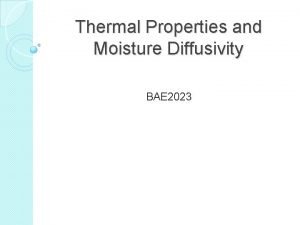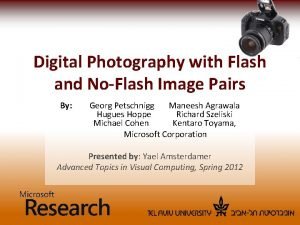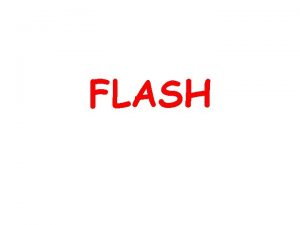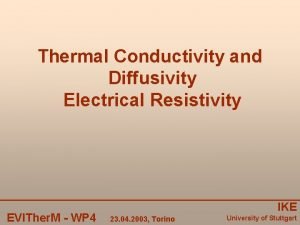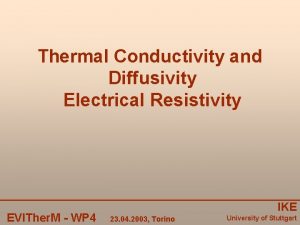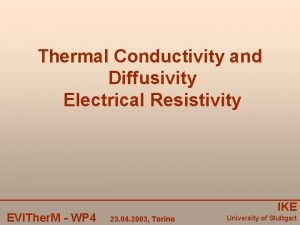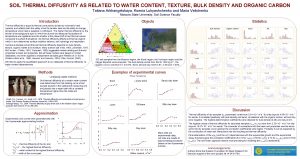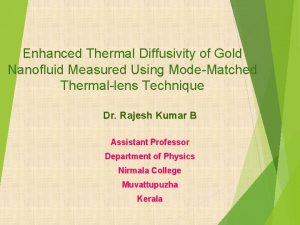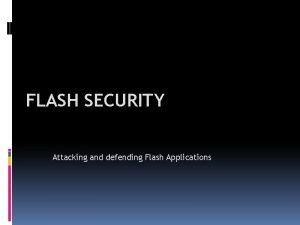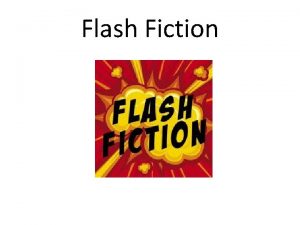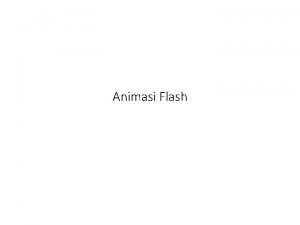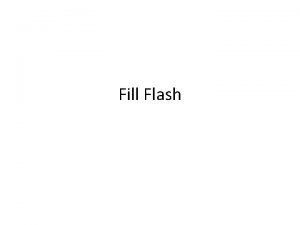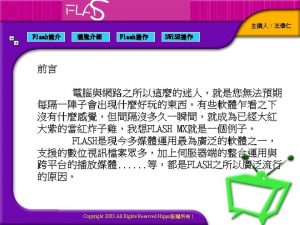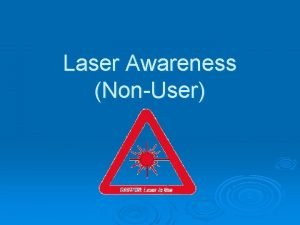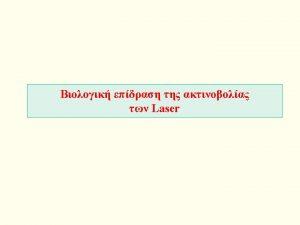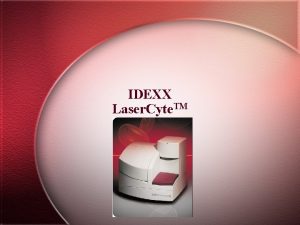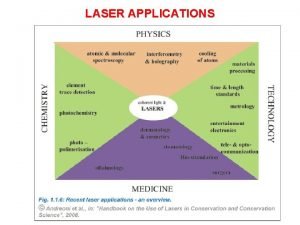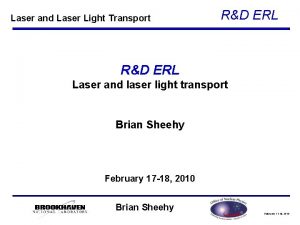Laser Flash Method for Effective Thermal Diffusivity Measurement




















- Slides: 20

Laser Flash Method for Effective Thermal Diffusivity Measurement of Pebble Beds CBBI-16 Portland, OR, USA Sept. 9, 2011 Mu-Young Ahn 1, Duck Young Ku 1, Yi-Hyun Park 1 , In-Keun Yu 1, Seungyon Cho 1 1 National Fusion Research Institute, Daejeon, Korea 0

Contents I Introduction II Laser Flash Method III IV Preliminary Experiments & Construction of Laser Flash Apparatus Summary & Future Works 1

KO HCSB TBM Design n The Helium Cooled Solid Breeder TBM consists of – – Reduced Activation Ferritic/Martensitic steel as a structural material High pressure helium as a coolant Atmospheric pressure helium with 1% hydrogen as a purge gas Three materials in breeding zone • Li 4 Si. O 4 or Li 2 Ti. O 3 pebble as a breeder • Be pebble as a multiplier • Graphite pebble as a reflector 2

Thermo-mechanics of Pebble Bed n It is very important to know thermo-mechanical behavior of pebble bed for TBM design & qualification – The breeding zone is packed in pebble form • The pebble size is around 1 mm (specific size and packing fraction for each material TBD) • Some properties of pebble bed is different from those of pebble itself (ex. effective heat conductivity vs. heat conductivity) – Pebble bed properties will change during the operation • Pebble bed is deformed by thermal stress • Local packing fraction is affected due to pebble moving – Thermal & mechanical properties should be measured simultaneously • Thermal & mechanical properties are strongly coupled 3

Tests for Pebble Bed & Objectives n Following tests for pebble bed are foreseen – Out-of-pile tests • Thermal properties (Cp) • Thermo-mechanical properties (effective thermal conductivity, effective thermal expansion rate, effective stress-strain correlation, thermal creep, pebble bed failure data, etc) • Wall interface data (heat conductance, friction coefficient, etc) – In-pile tests n Construction of various facilities is planned and on-going – Thermo-mechanical data should be established for KO TBM and future breeding blankets – Specially the KO concept has unique feature of having graphite reflector • No pebble bed data on graphite reflector pebble bed n Ojectives of the study – Preliminary results with laser flash method – Construction of laser flash apparatus with axial compression 4

Contents I Introduction II Laser Flash Method III IV Preliminary Experiments & Construction of Laser Flash Apparatus Summary & Future Works 5

Measurement Method? n Thermal conductivity vs. Effective thermal conductivity Thermal Cond. Effective Thermal Cond. Remark ~1 hot wire Ceramic Breeder Beryllium Multiplier 80~200 W/m/K 3~14 heat flow method / guarded hot plate Graphite Reflector 100~150 W/m/K ? ? - Wide range of thermal properties From the NETZSCH viewgraph 6

Laser Flash Method (1) n Laser flash method is a transient method widely used in industry – – High accuracy and repeatibility with wide range of thermal diffusivity (conductivity) measurement Absolute measurement technique (no calibration with other materials) Small sample size and easy sample preparation Short measurement time – Heat capacity and density required for heat conductivity calculation – Sample thickness limitation mainly due to mathematical model and laser power • Corrections required for radial and facial heat loss, and finite pulse effects (ex. Advanced Cape-Lehman approach) • Sufficient laser power should be chosen Transient 1 D Heat Equation - initial condition (laser source) - boundary conditions (adiabatic) From the NETZSCH viewgraph 7

Issues on Pebble Beds Measurement n Laser Flash Method? – Wall influence effect on sample thickness • It is known that minimum thickness is required to behave as “pebble bed” • It is expected that the effective thermal property shows asymptotic behavior according to increasing thickness • Is it possible to measure by LFM up to the minimum thickness? • Preliminary test was performed to see feasibility regarding the thickness issues – Thermal & mechanical properties are strongly coupled • Compression load device & pebble holder were designed 8

Contents I Introduction II Laser Flash Method III IV Preliminary Experiments & Construction of Laser Flash Apparatus Summary & Future Works 9

Preliminary Experiments (1) n Preliminary experiments were performed to see feasibility regarding the thickness issue – The measurement was done at 25 o. C in accordance with ASTM E-1461 – 2 mm graphite pebbles were packed in special crucibles covered with sapphire glass - Bad detector signals - No reproducible values - Good detector signals - Reproducible values 10

Preliminary Experiments (2) n Preliminary experiments were performed to see feasibility regarding the thickness issue – Only ~3 x. D thickness shows the saturated value – Adopting 20 J/pulse laser makes pebble bed measurement over 10 mm possible - Bad detector signals - No reproducible values - Good detector signals - Reproducible values 11

Construction of Laser Flash Apparatus (1) n The facility requirements for thermal properties – Effective thermal diffusivity (conductivity) is measured with axial compression load • Graphite reflector pebble bed • Ceramic breeder pebble bed Parameter Value Measurement Materials Solid, Liquid, Powder, Pebble Bed (with pebble crucible) Temperature RT ~ 1500 o. C Compression load Up to 10 MPa Test section atmosphere Vacuum ~ 1. 5 bar (filling or purging up to 200 ml/min) Performance Heat diffusivity range 0. 01 ~ 1000 mm 2/s Heat conductivity range 0. 1 ~ 2000 W/m/K Accuracy ± 5% or better for standard materials Repeatability ± 3% or better for standard materials 12

Construction of Laser Flash Apparatus (2) n NETZSCH LFA 427 with special design – Compression load device – Sample holder for pebble bed 13

Construction of Laser Flash Apparatus (3) n Compression load device – – Pressure stamp exerts compression load on the load ring Compression load is controlled pneumatically using MFC, EPC Compression load is maintained at specified stress Displacement is recorded by digital dial guage 14

Construction of Laser Flash Apparatus (4) n Sample holder for pebble bed – Pebbles are confined by two sapphire discs and the container – Sapphire disc is coated by graphite for laser power absorption and emission – Maximum sample thickness is set to 10 mm which is considered to be enough according to the preliminary experiment results 15

Construction of Laser Flash Apparatus (5) n The apparatus was constructed in 2010 – Now commissioning is on-going • Li 2 Ti. O 3 measurement for comparison with previous studies • Background thermal expansion experiments 16

Contents I Introduction II Laser Flash Method III IV Preliminary Experiments & Construction of Laser Flash Apparatus Summary & Future Works 17

Summary & Future Works n Summary – Laser flash method was chosen as measurement method for effective thermal diffusivity (conductivity) • Preliminary test was performed to investigate feasibility of laser flash method – Laser flash apparatus was constructed and commissioning is on-going • Compression load device and sample holder were designed for pebble bed measurement • Li 2 Ti. O 3 measurement for comparison purpose with previous studies and background thermal expansion experiment are on-going n Future works – Validation of modified calculation logic to take thickness change into account is required – Validation of compression load(to reduce compression load variation) and displacement measurement is necessary 18

Thank you for your attention! 19
 Thermal diffusivity
Thermal diffusivity Digital photography with flash and no-flash image pairs
Digital photography with flash and no-flash image pairs Thermal energy section 3
Thermal energy section 3 Thermal transfer vs direct thermal printing
Thermal transfer vs direct thermal printing Advantages and disadvantages of symposium
Advantages and disadvantages of symposium Fspos
Fspos Novell typiska drag
Novell typiska drag Tack för att ni lyssnade bild
Tack för att ni lyssnade bild Ekologiskt fotavtryck
Ekologiskt fotavtryck Varför kallas perioden 1918-1939 för mellankrigstiden?
Varför kallas perioden 1918-1939 för mellankrigstiden? En lathund för arbete med kontinuitetshantering
En lathund för arbete med kontinuitetshantering Särskild löneskatt för pensionskostnader
Särskild löneskatt för pensionskostnader Personlig tidbok
Personlig tidbok Sura för anatom
Sura för anatom Förklara densitet för barn
Förklara densitet för barn Datorkunskap för nybörjare
Datorkunskap för nybörjare Boverket ka
Boverket ka Att skriva en debattartikel
Att skriva en debattartikel Delegerande ledarstil
Delegerande ledarstil Nyckelkompetenser för livslångt lärande
Nyckelkompetenser för livslångt lärande Påbyggnader för flakfordon
Påbyggnader för flakfordon
